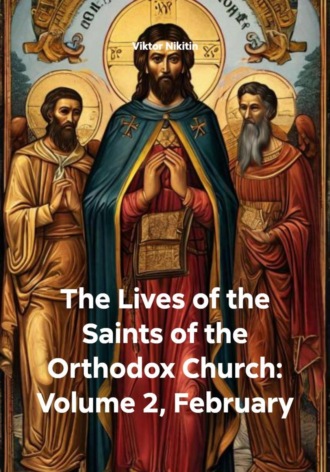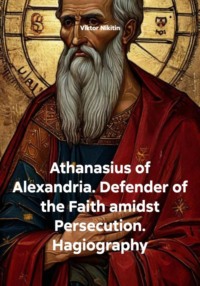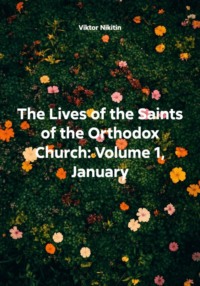
Полная версия
The Lives of the Saints of the Orthodox Church: Volume 2, February
Prophet Zachariah:
Zachariah, a revered Old Testament prophet and priest, lived during the 6th century BCE. He is notably the father of John the Baptist and a key figure in the Messianic prophecies. According to the Gospel of Luke, Zachariah was struck mute by the angel Gabriel for doubting the birth of his son until the prophecy was fulfilled. His prophetic book, The Book of Zechariah, contains vivid visions foretelling the coming of the Messiah, the restoration of Jerusalem, and God’s ultimate plan for salvation. He symbolizes faithful obedience amid exile and serves as a bridge between the Old and New Testaments.
Saint Sabbas II, Archbishop of Serbia:
Saint Sabbas II served as the Archbishop of the Serbian Orthodox Church during the late 13th and early 14th centuries, a period marked by political upheaval and external threats. He was a staunch defender of Orthodox faith and tradition, guiding his flock through challenges with pastoral care and wisdom. His leadership helped consolidate the Church’s position in Serbia, strengthening monastic life and liturgical practice. He is remembered for his humility, scholarly pursuits, and efforts to cultivate unity among clergy and laity.
Martyrs Nikephoros and Stephen:
Saints Nikephoros and Stephen were early Christian martyrs who suffered under imperial persecution. Though precise historical details are limited, their witness is commemorated for the courage they displayed in the face of trials, refusing to renounce Christ despite threats of torture and death. They represent the countless unnamed faithful who laid down their lives for the Gospel in the early centuries of Christianity.
Martyrs Philadelphos and Polycarp:
Philadelphos and Polycarp were martyred during the same era of widespread persecution. Their steadfast faith in Christ inspired many believers, encouraging perseverance amid hardship. They are honored for their martyrdom as a testament to the power of faith and the strength bestowed by God to endure suffering.
Saint Makarios, Bishop of Paphus:
Saint Makarios was a prominent bishop in the city of Paphus on the island of Cyprus during the early Byzantine period. Known for his pastoral zeal, he actively defended Orthodoxy against heretical teachings, supported the poor, and cared for the spiritual welfare of his flock. His episcopal tenure was marked by holiness, wisdom, and miracles attributed to his intercession. He is often depicted holding a shepherd’s staff, symbolizing his role as a spiritual guide.
Saint Pergetos:
Little is known about Saint Pergetos, but tradition holds him as a holy ascetic and monastic figure renowned for his life of prayer and fasting. His commitment to solitude and contemplation exemplified the eremitic ideals cherished in the early Church. His feast day honors the spirit of humility and self-denial.
Saint Kew, Virgin of Cornwall:
Saint Kew was a holy virgin from Cornwall, England, venerated for her purity, deep faith, and charitable works. She is believed to have lived in the early medieval period, dedicating her life to God in a time when Christianity was still establishing roots in the British Isles. Churches and holy wells in Cornwall bear her name, testifying to her lasting influence. Local legends recount miracles attributed to her intercession, including healing and protection of travelers.
Saint Cuthman, Hermit of Steyning:
Saint Cuthman was a humble shepherd and later hermit who lived near Steyning in Sussex, England, during the 7th or 8th century. According to tradition, he carried his elderly mother on his back as he sought a place of solitude and prayer. His piety and miracles attracted disciples, and he became renowned for his kindness and healing powers. His hermitage served as a spiritual refuge for many and his memory is honored in local churches and folklore.
Saint Elfleda, Abbess of Whitby:
Saint Elfleda was a royal daughter of King Edwin of Northumbria and served as abbess of the celebrated Whitby Abbey in the 7th century. Following in the footsteps of Saint Hilda, she guided the abbey through a period of spiritual and educational flourishing. Known for her wisdom, administrative skill, and deep spirituality, she fostered the growth of Christian learning and monastic discipline. Under her leadership, Whitby remained a key center of Celtic and Roman Christian traditions.
Virgin-Martyrs Martha and Mary, and their brother Lycarion, in Egypt:
Saints Martha and Mary, along with their brother Lycarion, were members of a devout Christian family in Egypt who suffered martyrdom for their faith during Roman persecutions, traditionally dated to the 3rd or 4th century. Renowned for their steadfastness, they endured imprisonment and torture rather than renounce Christ. Their story reflects the strong family bonds united in faith and the willingness to sacrifice earthly life for eternal salvation. They are commemorated for their courage and piety, inspiring Christian families to remain faithful amid trials.
* * *
Lives of the Saints Celebrated on February 9
Martyr Nicephorus of Antioch:
Saint Nicephorus lived during the early centuries of Christianity in the city of Antioch, a major center of Christian life and thought. As a devout believer, he openly confessed his faith in Christ at a time when the Roman authorities were actively persecuting Christians. Despite facing brutal torture designed to force him to renounce Christianity, Nicephorus remained steadfast. Ultimately, he was martyred by the sword, becoming a shining example of courage and unwavering faith. His martyrdom inspired many in Antioch and beyond to remain faithful amid persecution.
Hieromartyrs Marcellus, Bishop of Sicily; Pancratius, Bishop of Taormina; and Philagrius, Bishop of Cyprus:
These three holy bishops lived in the early 4th century, a turbulent era marked by widespread Christian persecution under Emperor Diocletian.
Marcellus of Sicily shepherded his flock with zeal and charity, despite the threat of death. Arrested for refusing to sacrifice to pagan gods, he endured imprisonment and harsh treatment before being put to death.
Pancratius of Taormina similarly faced martyrdom for upholding the Christian faith. His courage in the face of torture made him a beacon of strength for Christians on the island of Sicily.
Philagrius of Cyprus was also a defender of Orthodoxy, witnessing to the truth of the Gospel with his life. His martyrdom added to the spiritual heritage of the Cypriot Church.
Together, they represent the many bishops who sacrificed their lives to preserve the faith during one of its darkest periods.
* * *
Martyr Peter Damascene:
Peter Damascene was a devout Christian layman who suffered for his faith under persecution, likely in the Eastern Roman territories. He lived a pious life, known for charity and devotion, and when brought before the authorities, he refused to abandon Christ. His martyrdom was a testament to his deep spiritual conviction and inspired many Christians to persevere.
Saints Nicephorus and Gennadius, monks of Vazheozersk (Vologda):
These two monks lived in the wilderness of northern Russia, near Vazheozersk in the Vologda region, during the medieval period. They embraced the rigors of monastic asceticism—fasting, prayer, and solitude—dedicating their lives entirely to God. Their sanctity was confirmed by miracles attributed to them, and their example attracted disciples and pilgrims, helping to establish monastic spirituality in this remote region.
Saint Pancratius, hieromonk of the Kiev Caves:
As a hieromonk—a monk who was also a priest—at the Kiev Pechersk Lavra, one of the most important spiritual centers of Eastern Orthodoxy, Saint Pancratius was known for his deep humility, tireless prayer, and wise counsel. He lived during the 11th or 12th century, a time when the Kiev Monastery was flourishing. Pancratius labored both in liturgical service and in spiritual direction, helping to nurture the monastic and wider Christian communities.
Saints Aemilianus and Braccchio of Tours (Gaul):
These saints were early missionaries and monastic founders in what is now France.
Saint Aemilianus is remembered for his ascetic life and role in spreading Christianity in Gaul.
Saint Braccchio was known for his strict asceticism and the foundation of monastic communities that helped establish Christian life in the region. Their holy lives significantly contributed to the Christianization of Western Europe in the early Middle Ages.
* * *
Saint Teilo, Bishop of Llandaff:
A prominent Welsh bishop and saint of the 6th century, Saint Teilo was a disciple of Saint David, the patron saint of Wales. He was known for his missionary zeal, founding churches, and monasteries, especially in South Wales. He played a key role in spreading Christianity and was famed for miracles, including healing and protection from invaders. His feast is celebrated especially in Welsh Orthodoxy and Roman Catholicism.
Saint Roman of Cilicia:
This holy bishop served in Cilicia, a Roman province in Asia Minor (modern Turkey). Known for his pastoral care and devotion, Saint Roman lived a life marked by humility and doctrinal soundness, strengthening the Christian community during difficult times. Though little is known about the details of his life, his holiness and episcopal leadership have been honored through the centuries.
Martyr Apollonia, Deaconess of Alexandria:
Saint Apollonia was a deaconess in the early Church in Alexandria, Egypt. During a violent persecution, she was seized by a mob that subjected her to terrible torture, including the breaking of her teeth, intended to force her to deny Christ. Instead, she willingly embraced martyrdom by leaping into the flames. She became one of the most venerated virgin martyrs of the early Church and is especially invoked as the patron saint of those suffering from dental problems and toothaches.
Venerable Shio Mgvime:
One of the renowned Thirteen Assyrian Fathers who brought monasticism to Georgia in the 6th century, Venerable Shio settled in a remote rocky gorge near Mtskheta, founding the Shio-Mgvime Monastery. He lived as a strict ascetic, practicing intense prayer, fasting, and manual labor. His spiritual influence shaped Georgian monasticism and inspired generations of monks. His relics are venerated as a source of blessings and miracles.
Translation of the relics of Innocent, first Bishop of Irkutsk (see also November 26):
Saint Innocent (Veniaminov) was a pioneering missionary bishop in Siberia and Alaska during the 19th century. His missionary zeal brought the Orthodox faith to many indigenous peoples. The "translation" of his relics refers to the solemn moving of his holy remains to a new resting place, often associated with miracles and increased veneration. This event highlights the ongoing spiritual legacy of his missionary work.
Other commemorations:
Repose of Maria, desert-dweller of Olonets:
Saint Maria lived as a solitary ascetic in the forests near Olonets, Russia. Known for her extreme humility, deep prayer life, and renunciation of worldly comforts, she attained great spiritual heights. Her passing is remembered by the faithful as the repose of a holy woman who bore witness to Christ through her quiet, hidden life.
Конец ознакомительного фрагмента.
Текст предоставлен ООО «Литрес».
Прочитайте эту книгу целиком, купив полную легальную версию на Литрес.
Безопасно оплатить книгу можно банковской картой Visa, MasterCard, Maestro, со счета мобильного телефона, с платежного терминала, в салоне МТС или Связной, через PayPal, WebMoney, Яндекс.Деньги, QIWI Кошелек, бонусными картами или другим удобным Вам способом.











